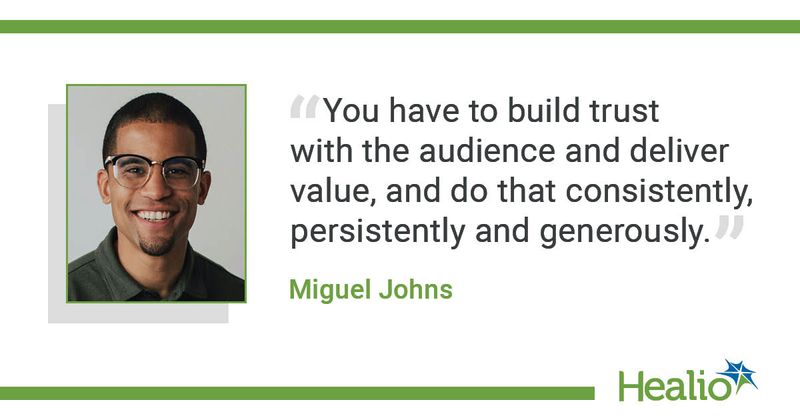Produce engaging social media content to enhance diabetes care and education
Social media can promote engaging and informative diabetes education content while also fostering a support network for people with diabetes, according to two speakers.
In a 10-day program conducted in a private Facebook group with people with diabetes, researchers created informational videos and other content to encourage participants to eat healthier and engage in physical activity. At the end of the program, the cohort showed improvements in overall energy, exercising, physical function, pain management and blood glucose levels.

“My role was to bring the diabetes educator to the forefront and to get all of these individuals with diabetes together for a challenge,” Lorena Drago, MS, RND, CDN, CDCES, registered dietitian and certified diabetes care and education specialist for Hispanic Foodways LLC, told Healio. “We feel the challenges are a great way to engage persons that are living with diabetes or any other chronic condition to have them support one another, but also see in a short time what a challenge can actually do to improve health.”
Drago and Miguel Johns, CEO of KingFit, described how to create engaging diabetes-related content on social media at the Association of Diabetes Care & Education Specialists virtual conference.
Keys to creating engaging content
Use of social media has increased dramatically in the past 10 years, with more than half of adults aged 18 to 64 years using at least one social media site, according to data from the Pew Research Center. The increase in social media use has given diabetes care and education specialists a new way to reach people with diabetes. However, the saturation of information on social media platforms means educators must create engaging content that will stand out to users.
Johns described how his organization, KingFit, spent the last few years designing new ways to engage people with diabetes. The company launched two pages on Facebook: DiabetesCare and DiabetesCare Español. Infographics, videos, links and other media have been shared on both pages, and page administrators take time to review metrics to determine what type of content followers are engaging. Johns said reading comments and seeing what followers were most interested in were major considerations when creating content.
“You have to build trust with the audience and deliver value, and do that consistently, persistently and generously,” Johns told Healio. “If you are able to execute on those things, leveraging your expertise and understanding the landscape and the toolkits, then you can have success.”
Johns added that diabetes care and education specialists should create content that is unique and authentic. Finding a process that does not require a large financial investment and makes it easier to duplicate is a key to building a strong group of followers that will continue to return to a page and engage for longer periods of time.
“You need to have a long trail of content,” Johns said during the presentation. “Whether it is a video series, an e-book series, a webinar series, there needs to be some sort of follow-up that you can implement, so that although somebody can start with you on the first video, you have a path that leads them all the way to your call to action. By the time they get to your call to action, they’re ready to get started.”
Diabetes challenge leads to improved health
To follow-up on the engagement of the DiabetesCare Español Facebook page, researchers invited followers to join a 10-day diabetes challenge. Participants joined a separate private Facebook group where they attempted to complete daily tasks with the assistance of educational posts from Drago and connected with other people in the challenge.

“[The challenge program] encompasses all of the behaviors that are necessary for people with diabetes to live healthy lives,” Drago told Healio. “It includes every area: preventing complications, managing complications, eating healthily, managing your medications, visiting your doctor. The group also serves to support one another, to cheer each individual on.”
During the challenge, participants attempted to complete 12 tasks per day. The tasks were centered on three pillars: healthy eating, physical activity and smart testing.
“We wanted people to be able to connect with the [glucose] numbers,” Drago said during the presentation. “We wanted them to be able to look at trends, and also we wanted to be able to start making changes based on those values. Not just something they take to their doctors every 3 or 6 months, but changes that actually are meaningful.”
Many of the videos created for the challenge are short clips focusing on specific areas of diabetes management. The videos for the challenge were centered on topics and questions participants raised in the Facebook group, allowing administrators to tailor content to what was most important to the cohort. The videos included physical props, such as measuring cups, menus and food items, to add visual appeal and make them easier to understand. Since the cohort was a Spanish-speaking group, there was also a focus on encompassing cultural foods participants were more likely to include in their diet.
Engagement among participants was a big part of the challenge. According to Drago, 40% of behavior change occurs with peer support. She said the Facebook challenge group gave participants the ability to connect with both her and their peers.
Based on surveys and data collected during the challenge, the cohort reported improvements in several areas. Participants had a 29% improvement in physical functioning, 32% increase in energy, a 26% improvement in pain management and a 9% improvement in general health. Physical activity increased by a mean of 81 minutes per week, and mean blood glucose levels decreased by 35.75 mg/dL during the challenge. Among the participants, 70% continued to engage in the group 3 months after enrollment.
“The combination of social media where people were spending their time on a daily basis, with the expertise of a diabetes educator like [Drago], and powered by the peer-to-peer support, led to a fantastic engagement rate,” Johns said.

